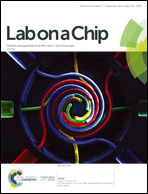A one-stop microfluidic-based lung cancer organoid culture platform for testing drug sensitivity†
Abstract
Microfluidic devices as translational research tools provide a potential alternative to animal experiments due to their ability to mimic physiological parameters. Several approaches that can be used to predict the efficacy or toxicity of anticancer drugs are available. In general, standard cell culture systems have the advantages of being relatively cost-effective, having high-throughput capability, and providing convenience. However, these models are inadequate to accurately recapitulate the complex organ-level physiological and pharmacological responses. Here, we present a one-stop microfluidic device enabling both 3-dimensional (3D) lung cancer organoid culturing and drug sensitivity tests directly on a microphysiological system (MPS). Our platform reproducibly yields 3D lung cancer organoids in a size-controllable manner and demonstrates for the first time the production of lung cancer organoids from patients with small-cell lung cancer. Lung cancer organoids derived from primary small-cell lung cancer tumors can rapidly proliferate and exhibit disease-specific characteristics in our MPS. Cisplatin and etoposide, the standard regimen for lung cancer, showed increased apoptosis induction in a concentration-dependent manner, but the organoids contained chemo-resistant cells in the core. We envision that this system may provide important information to guide therapeutic approaches at the preclinical level.



 Please wait while we load your content...
Please wait while we load your content...